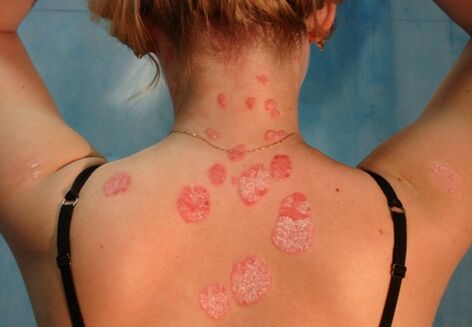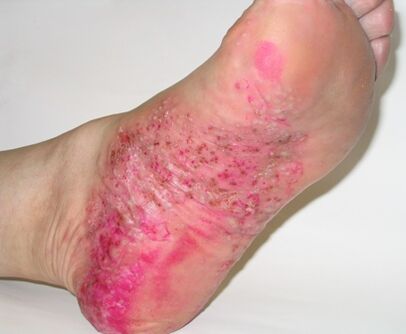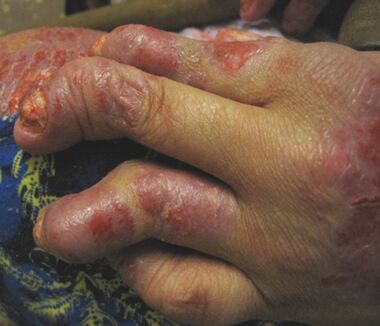According to the WHO, currently 2-4% of the world's population suffers from psoriasis. This disease affects patients of all ages, however, most often young people (15-25 years old). Unfortunately, today medicine is not able to completely cure psoriasis, but timely professional treatment significantly improves the quality of life. So, in case of detection of the first symptoms, it is better to consult a doctor immediately.
psoriasis- This is a dermatosis, which manifests itself in the form of scaly papules on the skin. Its distinguishing feature is that, in addition to the skin, it is capable of affecting joints and nail plates. In the pathogenesis of psoriasis, hereditary factors are clearly traced, and other irritants are only secondary causes of its occurrence.
During an exacerbation of the disease, the natural processes of formation - keratinocytes (cells of which mainly human skin is composed) are disrupted. There are also marked biochemical changes in the skin. In addition, recently, doctors have been able to determine that during the acute phase of the disease, the functioning of the nervous system also varies from the norm. In general, the main reason for the appearance of psoriasis is the presence of malfunctions in the functioning of the immune system.
Prevalence of psoriasis
Psoriasis is common. At present, the incidence statistics are approximately as follows:
- China - 0. 3%;
- US - 1%;
- Denmark - 1-2. 3%;
- Northern Europe - 3%;
- Germany - 1-1. 3%.
Curious course that the indigenous population of South America is not affected by the disease. At least no such case has been reported so far. If you look at the situation as a whole, then the percentage of psoriasis is approximately 6-8% of all skin diseases.
As already noted, psoriasis occurs at any age, but more often young people (up to 25 years old) still suffer, and it occurs with the same frequency in men and women.
Epidemiological situation
Based on the causes of occurrence, psoriasis is a non-infectious disease with a pronounced genetic predisposition. The most at risk of getting sick are those people whose relatives also suffer from this disease (in this case, only the closest relatives are meant). European researchers have proven with certainty that if one of the parents is ill, then he has a 14-25% probability of passing it on to his child. If both parents are ill, this probability is already 41-60%.
According to the type of disease development, psoriasis is divided into two groups:
- early;
- LATER
This is evidence that there are two main types of psoriasis (like diabetes mellitus). The first occurs in people at an early age (average 16-22 years), is strictly hereditary in nature and is directly related to the HLA phenotype (HLA-Cw6). The course of the disease is often severe and over time the disease only progresses.
The causes of type II psoriasis are quite random, so this disease is sporadic. Occurs most often in older people (around 60 years old). In general, it persists easily, however, in some cases, it can be aggravated by joint and nail damage.
Factors that provoke the appearance of psoriasis
Although psoriasis tends to be inherited, it is generally multifactorial. Anything can cause that fatal immune system malfunction. So provocative factors are divided into external and internal (or, in scientific terms, exogenous and endogenous).
Exogenous factors

They, in turn, are divided into physical and chemical. The former include common mechanical damage to the skin, such as domestic injuries, thermal burns, scratches, wounds, tattoos, scratches, insect bites, and pets. Cases of psoriasis at injection sites have also been reported. X-rays and ultraviolet radiation also play an important role. In about 5% of all cases, the disease occurs in the summer, and 40% of them are due to sunburn.
Chemical factors are expressed in the toxic effect of harmful chemicals or other irritants on the skin. In addition, psoriasis is provoked by other skin diseases, such as:
- dermatosis;
- fungal infections;
- adhesive impetigo;
- acne;
- dyshidrosis;
- lichen;
- shingles;
- gangrenous pyoderma;
- allergic dermatitis of various nature.
There are known cases of the disease after performing basic diagnostic skin tests to detect the body’s reaction to cosmetics, hygiene products, formalin, chromium, nickel and other chemicals.
Endogenous factors
Internal causes of psoriasis can be infectious diseases. Recent research in this area suggests that streptococcal infections and HIV are more likely to be blamed. Moreover, often the symptoms do not appear during the disease itself, but even after the usual vaccination. In these cases, psoriasis is often difficult to treat.
In order to induce remission, lithium preparations, beta-blockers, non-steroidal anti-inflammatory drugs, and ACE inhibitors are used. Corticosteroids are contraindicated in this case.
Pregnancy and childbirth
Significant changes in hormonal levels caused by pregnancy can also become a provocative factor. A similar pattern is observed during puberty. It is also curious that women who already have psoriasis may experience an improvement in their condition during pregnancy (40%). Worsening is much less common (only in 14% of cases). True, after birth in most patients, the condition worsens again (in 54% of cases)
Diet and food
These factors often do not have a noticeable effect on the course of the disease. It is only known with certainty that alcohol and cigarette abuse significantly increase the chance of developing psoriasis and worsen its course.
Hypocalcemia and hypokalemia
These factors may provoke the onset of generalized pustular psoriasis. The chances of a favorable outcome in this case are very small.

Pustular psoriasis.
Psychogenic factors
Their role today is considered quite controversial. Some researchers claim that the presence of psychogenic traumatic factors provokes psoriasis in 60% of all cases. However, it is only known with certainty that they can only worsen the course of the disease and reduce the effectiveness of therapy.
Distribution
At present, several specific types of psoriasis have been identified. They differ significantly in the clinical picture and the degree of effect on the body, therefore, to have an idea of what is at stake, it is better to look at the World Wide Web and carefully study the photos of psoriasis of various etiologies, as well as get acquaintedwith description.
Vulgar psoriasis
Vulgar or common psoriasis occurs in most cases. This disease manifests as an abundant rash of small, bright red papules (from a matchstick to a pea). After emergence, they quickly grow and on their surface appear silvery white scales. In the future, papules turn into plaques, which coalesce into a large lesion. Too often they have clear boundaries that separate them from healthy skin.
When you try to comb or remove the papule, the onset of inflammation increases. This phenomenon is known as the "stearin point symptom" and once all the scales have been removed, a smooth, polished surface can be found, the "terminal film symptom". If you continue to scratch, the capillaries are injured and blood droplets are released. This symptom is known as "blood dew".
The development of psoriasis is divided into three main periods:
- progressive (acute);
- stationary;
- settlement period.
The success of the treatment here above all depends on how accurately the methods of therapy are chosen, since, depending on the period, their effectiveness varies considerably.

Period of progress. A feature of this stage is the abundant appearance of a specific rash. In the deterioration phase, certain parts of the patient's body are covered with small papules, which are actively peeling off. Peeling in this case is strictly localized and does not affect healthy skin. It is easy to identify acute psoriasis with the characteristic red or pink border that borders the papule.
The most characteristic symptoms at this stage are itching and the presence of the so-called Koebner symptom. The latter is expressed in the fact that psoriatic papules appear at the site of any skin damage (minor burns, scratches, injections, scratches, etc. ). This phenomenon occurs on average two weeks after the injury itself and occurs in 38-76% of all patients.
It is also extremely curious that (much less often) the opposite effect is observed. Scientists believe it is caused by the presence in the blood serum of some patients with specific factors that inhibit Koebner syndrome.
Stationary period. On average, 2-3 months after the appearance of the first rashes, the formation of new papules stops. Tile growth also stops. At this stage, their entire surface is already covered with scales. This period can last for months or even years. However, the latter is relatively rare.
Settlement period. This period is also called a regressive period, as during it a gradual decrease of the plates is observed. At first, they stop peeling, and then gradually soften until they disappear completely. If the disease is mild, this phenomenon occurs spontaneously. Treatment only speeds up its onset. Often, the location of the plaques stands out against the background of healthy areas of skin from depigmentation or, which occurs somewhat less frequently, from hyperpigmentation. With psoriasis vulgaris, rashes can occur almost anywhere, and they are usually localized symmetrically (elongated surfaces of the elbows and knees). It can also appear on the head, sacrum, hands, palms, heels, groin and armpits. In addition, in many cases, nail plates are also affected (appearance of punctured pits, relief, thickening). These symptoms are very similar to those that occur when infected with fungi, so the final diagnosis is made only after you receive a negative reaction to fungal spores in a separate laboratory study. Psoriasis vulgaris as a whole does not have an overall negative effect on the patient's body and its course is chronic. Periods of deterioration occur in autumn or winter, while in summer deteriorations, by contrast, are much less common. The main impetus for active treatment lies in the fact that without proper therapy, psoriatic plaques can cover the body for years, while adequate treatment causes improvement after a few months.
Psoriatic erythroderma
Psoriatic erythroderma is one of the most unpleasant forms of this disease. On average, a similar reaction is observed in about 2% of patients and occurs both spontaneously and as a result of improperly chosen treatment. Although, of course, if the medication used irritates the skin or is exposed to ultraviolet radiation, the risk of psoriatic erythroderma is much higher. Most often, psoriatic erythroderma appears suddenly during the first stage of psoriasis. It can be combined with generalized pustular arthritis and psoriasis and exposure to factors such as streptococcal infections or hypocalcemia significantly increases the likelihood of such a complication. Immediate withdrawal of corticosteroids may worsen the condition. The appearance of erythroderma completely eliminates the clinical symptoms of psoriasis, which are replaced by diffuse skin rash, severe itching and lamellar peeling.
Pustular psoriasis
Also a severe form of psoriasis. It is characterized by the appearance of abscesses, which often remain the only symptom. Very rarely they are combined with the classic symptoms of psoriasis vulgaris. Pustular psoriasis is generalized and localized. The second differs only in that the abscesses in this case are concentrated only in the area of the palms or soles.
Psoriatic arthritis
Currently, psoriatic arthritis is classified as an autoimmune disease in its own right. It is expressed in bone and muscle damage in patients who already suffer from psoriasis or have a high risk of disease from a family history. Very often psoriatic arthritis is combined with classic psoriasis as well as psoriatic nail lesions. This disease is diagnosed by the appearance of back pain, accompanied by the following conditions:
- lack of a clearly stated reason for appearance;
- the patient's age is over 40 years;
- deep unexplained pain in the lower back or buttocks;
- unclear localization of pain;
- reducing pain after exercise;
- pain or stiffness is felt early in the morning or at night;
- the presence of pain with an excellent general condition of the musculoskeletal system.
Psoriasis of the nail plates
Very often, psoriasis vulgaris is associated with nail damage. In this case, their pronounced dystrophy is observed, as well as the characteristic symptoms of fungal infections. It is a frequent companion of psoriatic arthritis. Considering that about 4% of the world's population suffers from common psoriasis, then 30-50% of them also have nail psoriasis.
Treatment of psoriasis
Unfortunately, currently, the drug is still not able to cure psoriasis, as this requires a much deeper knowledge of the working features of the basic mechanisms of the human immune system. Since this type of study is progressing slowly, and the disease itself does not pose a particular threat to life, symptomatic therapy is currently a priority. Before starting treatment, the patient needs a thorough examination, as each organism contains an individual set of factors that affect the course of the disease. Gender, age, occupation, general health, type of psoriasis - all of these should be taken into account when prescribing therapeutic therapy. An important role is also played by determining the nature of the course of the disease, individual sensitivity to medication and the current stage of the disease.
General activities
First of all, the doctor must determine the mental and physical condition of the patient, assess the general condition of his body and find out how tolerant he is to the disease. The best prerequisites for effective treatment are a good rest, staying in a quiet environment, switching to a less intensive work environment or a short-term hospitalization. Various methods of psychotherapy (rehabilitation in seaside resorts with the use of cognitive-behavioral therapy, etc. ) are also quite well proven. It is also very important for the patient to know that the healing process is going well because, without getting a quick effect, about 40% of patients lose faith in the effectiveness of the therapy and begin to ignore it. It is important to remember that psoriasis is a chronic disease, therefore, the safety of therapy should be considered. Many drugs are toxic and can accumulate in the body, turning into a time bomb. An addictive effect is also possible, so it is best to save the most potent medications until the really dangerous symptoms appear.
Disease course and long-term prognosis
The course of psoriasis is often unpredictable. Modern doctors have practically no success in this, therefore, as before, psoriasis remains an unpleasant and uncontrollable disease. In each case, it proceeds completely individually, so any attempt to make a prognosis regarding the course of the disease, as well as the duration of the stages of deterioration and remission, is destined to fail in advance. Only one thing is satisfying - despite the difficulty of treatment, it rarely poses a real threat to the patient's life. As for psoriatic arthritis, this disease is much easier than rheumatoid arthritis, and reducing the quality of life of patients, compared to the latter, is very insignificant. Statistics show that with proper treatment, most patients with psoriatic arthritis remain functional and can lead a satisfying life. If the necessary therapy is lacking, or the disease continues with complications, joint deformities may develop with the further development of severe pathologies. However, such complications are found only in a very small number of patients with psoriasis. Most patients can rely on a gradual stabilization of the condition and the appearance of long-term remission (more than two years). In very rare cases, the disease mainly develops in the active phase, however, in this case, it can be localized effectively. An effective treatment for psoriasis today can be obtained in any major city. And, although, as you know, final recovery cannot be achieved, diet, medication and special procedures will soon do their job. Also, you will not need long-term treatment in a hospital. The doctor's task is only to quickly skip the first two stages of psoriasis and bring the person to remission. After that, the patient can only take care of himself, follow the instructions and forget about the disease for a long time.























